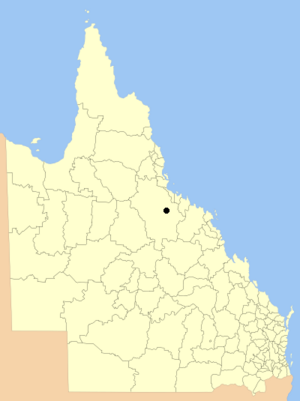Gugu-Badhun facts for kids

Gugu Badhun traditional lands
|
|
| Total population | |
|---|---|
| 1000-2000 | |
| Regions with significant populations | |
| Australia (Queensland) |
|
| Languages | |
| English, formerly Warrongo language and Gugu Badhun language |
The Gugu Badhun are an Aboriginal group of people. Their traditional lands are in the Upper Burdekin area of northern Queensland, Australia. This area is about 220 kilometers (about 137 miles) northwest of Townsville. It includes the small town of Greenvale and many large farms called pastoral stations. A book called Gugu Badhun: People of the Valley of Lagoons (published in 2017) tells us a lot about them.
Contents
Gugu Badhun Language
The Gugu Badhun people used to speak their own language, also called Gugu Badhun. It is thought to be a type of Warrongo language. The Gudjal language is also related to it.
Gugu Badhun Country
The Gugu Badhun people have a deep connection to their traditional lands, which they call "country." An early researcher named Norman Tindale thought the Gugu Badhun country covered about 3,367 square kilometers (1,300 square miles). He said it was east of the Great Dividing Range.
However, later researchers like Robert Dixon and Peter Sutton found that some of Tindale's ideas about the northern border were incorrect. They said that part of the land Tindale described actually belonged to the Warungu people.
Peter Sutton described Gugu Badhun country as being in the Upper Burdekin area, on both sides of the river. Their northern border was near Meadowbank, Glenharding, and Wairuna Stations, where they met the Warungu people. Their southern border was the Clarke River, where it joins the Burdekin. Here, they met the Gudjal people. These three groups, from north to south, shared some connections.
The landscape of Gugu Badhun country was shaped by ancient lava flows from the Kinrara volcano, which erupted about 7,000 years ago. The heart of their country is a place called the Valley of Lagoons. This area has many large, but shallow, lagoons near the Burdekin River. Some lagoons dry up in the long dry season, but others are always full because they are fed by springs. This constant water helps many birds, kangaroos, and other animals live there. Today, cattle also graze there.
The land near the water is green and thick with plants. But away from the water, the land changes. It becomes open woodland with eucalyptus trees, especially ironbarks, and a lot of grass. While it's not a desert, it's not super green either. You can see grey kangaroos and agile wallabies. Other animals like possums, echidnas, and bandicoots also live there. Large birds include emus and bustards. Smaller birds like apostle-birds, honeyeaters, and parrots make a lot of noise. In some places, the land looks rocky and bare, but under the surface, the cracked rocks hold the water that feeds the life-giving springs.
Native Title Rights
The Gugu Badhun people have native title over about 6,540 square kilometers (2,525 square miles) of their traditional country. This was officially recognized on August 1, 2012. This means they have special rights to their land.
The Gugu Badhun Aboriginal Corporation (GBAC) is a group that holds and manages these native title rights for the Gugu Badhun people. It was set up under a special law for Aboriginal and Torres Strait Islander corporations.
Gugu Badhun People and History
The Gugu Badhun people have always kept a strong connection to their land. They have faced many challenges, including when Europeans first arrived and took their land. But their story shows how they have achieved a lot despite these difficulties.
The first Europeans to meet the Gugu Badhun people were explorers led by Ludwig Leichhardt in 1845. This made the Gugu Badhun one of the first Aboriginal groups in inland Northern Australia to meet Europeans. In the 1860s, a group called the Native Police came. They tried to remove the Gugu Badhun people from their land so settlers could move in. Because the land was scrubby and hard to move through, the Gugu Badhun were able to resist these efforts for about 20 years.
Eventually, many Gugu Badhun people began to work on cattle stations. Today, Gugu Badhun people still have strong friendships with the families who own these farms.
In the 1930s and 1940s, many Gugu Badhun people who had stayed on their country decided to move to nearby towns and cities. They did this to get better education and job chances.
A Gugu Badhun man named Dick Hoolihan became a very important leader and activist. He was born in a cave in the Valley of Lagoons. He taught himself and became an Aboriginal activist in the 1950s. He was the first President of the Townsville Aboriginal Advancement League. He even encouraged Aboriginal stockmen (cowboys) in the Upper Burdekin area not to sign unfair work contracts. He was a very strong and active person. When he moved to Townsville, he was deeply involved in helping Aboriginal people.
Today, Gugu Badhun people gather on their country every year for a Culture Camp. This camp helps them stay connected to each other, to their land, and to their cultural values. Like all cultures, the Gugu Badhun identity has changed over time, but the Gugu Badhun people are very proud of their culture, their land, and their community.

